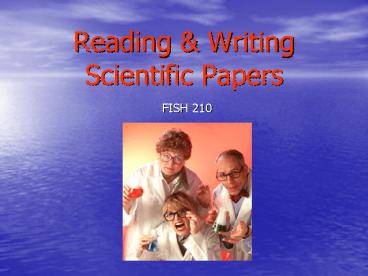Reading - PowerPoint PPT Presentation
1 / 18
Title: Reading
1
Reading Writing Scientific Papers
- FISH 210
2
Lab Overview
- Review of figure writing
- What makes a good scientific paper?
- Hand in page10 and 12-14 (due next lab)
3
Bad Figure
4
Good Figure
5
What is the purpose of scientific writing?
- Create a concise manuscript that cleanly presents
interprets your research. - Relay how findings are both unique important.
- Clearly define scope of work)
- What is scientific literature?
6
Basic Components of Scientific Papers
- Title
- Abstract
- Introduction
- Materials Methods
- Results
- Discussion
- Literature Cited
7
Title
- Descriptive, informative short (10-12 words).
- Make objective of study clear include key words
- Should NOT confuse reader with knowledge in your
field
8
Abstract
- Provide enough information to enable reader to
determine what, where, when, why, how, so what - People read quickly to assess relevance quality
of paper. - Difficult to write should be written after the
rest of the paper.
9
Introduction
- Provides a context for your research
- Motivate the reader review the relevant
literature - End Introduction with clearly defined hypothesis
being tested focused objectives of study
10
Materials Methods
- Should make research reproducible
- Detail experimental design
- Describe equipment used
- Define formulas and symbols
- Identify statistical approach
- Do not simply list your protocol, write it out if
possible
11
Results
- Introduce the principle findings
- Present tables and figures
- Include descriptions of important numbers, as
well as the results of any statistical tests - Example There was a significant difference in
the volume of the mascot animals (t 2.21, p
0.001). West Coast mascots were twice as large as
East coast mascots (Fig. 1). - Do NOT mix Results Discussion
12
PRECISION "experimental subjects were assaulted
with a wall of sound" "experimental subjects
were presented with 20 second pulses of
conspecific mating calls."
QUANTITATIVE vs. QUALTITATIVE "development rate
was fastest in the higher temperature treatment."
"development rate in the 30 C temperature
treatment was ten percent faster than development
rate in the 20 C temperature treatment"
13
Discussion
- Structured like pyramid.
- Specific findings to broader context
- Describe meaning of findings
- Interpret, draw conclusions from, discuss
significance of results - Acknowledge speculation
- Mention additional hypotheses developed from
results suggestions for future studies
14
Literature Cited
- This section should list references
- only those used in paper
- Cite articles within body of paper in two ways
- 1) Jones et al. (1987) found strong evidence for
a relationship between depth and diet. - 2) A relationship between depth and diet has been
demonstrated in several pelagic fishes (Jones et
al. 1987).
15
http//pubs.nrc-cnrc.gc.ca/eng/journals/instructio
ns/cjfas.html
- Newbury, M.G., and Ashworth, A.C. 2004. A
fossil record of colonization and response of
lacustrine fish populations to climate change.
Can. J. Fish. Aquat. Sci. 61(10) 18071816.
16
Recommendation for Success
- Robert Days book How to write and publish a
scientific paper Oryx Press, 5th edition
17
Common MistakesSignificantly erode the quality
of your paper
- Avoid cliches like the plague - they are old hat.
- Parenthetical remarks (however appropriate) are
(usually) unnecessary. - Also too, never use repetitive redundancies.
- No sentence fragments.
- Do not be redundant do not use more words than
you have to it is highly superfluous. - Don't use no double negatives.
- One word sentences? Eliminate.
- Eliminate commas, that are, not necessary.
- Exaggeration is a billion times worse than
understatement. - And finally, proffread carefully to see if you
any words out.
18
Top Ten Common Mistakes
- (1) Inappropriate writing style
- The more you read, the better your writing will
be. Trust us on this. - (2) Poor organization
- Outline outline outline! Thoughts and ideas
should progress in a logical, coherent manner. - (3) Poor paragraph structure
- A paragraph represents a collection of ideas and
thoughts about a clearly stated topic. - (4) Re-iterating the results in the discussion
- The discussion is where you draw some conclusions
about your work. Do not state them a second time.
- (5) Shabby figures and tables
- Dont use the default settings in Excel, EVER!
Make sure your axes are well labeled. Make sure
you units are specified. Make sure you table has
a header. Etc. Etc. Etc. - (6) Missing references, or inappropriate
references - Make sure that all references appearing in the
text are listed in the literature cited. Dont
cite a paper just because youve read it, and
dont cite a paper inappropriately i.e. claiming
a paper contributed a particular idea when the
paper was really about something else. - (7) Incorrect or inconsistent verb tense.
- Proofread carefully, and make sure your
references to your own work are always in the
past tense. Check all subject-verb agreements. - (8) Overuse of passive voice
- Spice up your writing by switching back and forth
between active voice and passive voice,
especially in the materials and methods. - (9) Unclear writing
- Writing id difficult dont be discouraged if you
have to work hard at it. Dont wait until the
night before the paper is due or your writing to
suffer. Revising the key! - (10) Missing or insufficient figure legends































